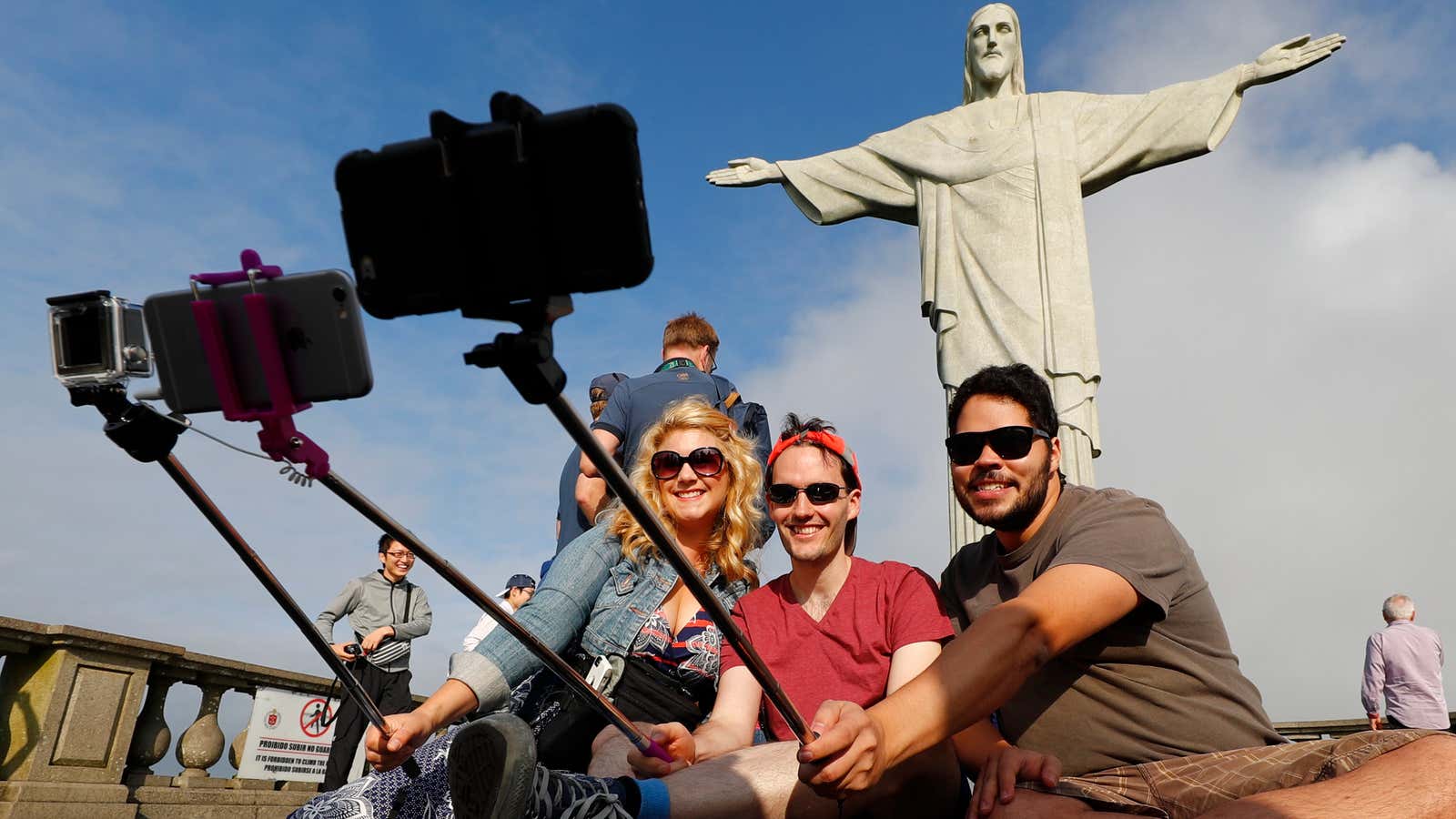The internet has a love-hate relationship with selfies. On one hand, everybody posts them. On the other, they are a sign of narcissism. They are linked to low self-esteem. They show that our culture has plunged into navel-gazing decadence and, more than that, they’re annoying. In a recent study, 82% of participants said they wished their social media feeds contained fewer selfies and more “regular” photos. Selfies: They will destroy us all.
But Ilan Stavans provides an alternate view in his recently published book-length essay, I Love My Selfie. Stavans, a professor of Latin American culture at Amherst College, believes the selfie can provide insight into our complicated efforts to create (and present) an authentic self. Whether obsessive, futile or even successful, selfies tell us something about being human. Which is to say, they’re art.
For Stavans, selfies are “mesmerizing as well as terrifying.” They are mesmerizing, he writes “because I can’t think of another cultural artifact that explains better, or complicates more, the map of our convoluted relationship with the self.” And they are terrifying, he believes, “because selfies in fact show the degree to which individualism … is the prime mover of humankind. We are all self-aggrandizing monsters.”
Critics of selfies say that they’ve made us even more monstrously narcissistic. But Stavans doesn’t buy it. In his view, we’re no more self-obsessed than famous showmen P.T. Barnum or Winston Churchill. “I think that there is no growth in narcissism,” he tells me. “It is not much worse than in the last 100 or 200 years. It’s just that we now have a telephone that has a camera that can be turned around and used to photograph ourselves.” Everyone from Elvis to Picasso to Marilyn Monroe would all have taken selfies if they had the chance.
Lots of artists did get as close to selfies as they could, Stavans points out. Painters from Rembrandt to Frida Kahlo to Andy Warhol created self-portraits in realistic and allegorical settings. Stavans singles out Magritte’s self-portraits as especially fascinating examinations of the self, because they are, “as much about absence and anonymity … as they are about exposure and celebration.” In one famous Magritte self-portrait, you see the back of the artist’s head as he stares into a mirror. But the mirror also reproduces the back of his head. In this depiction, the self looking at the self doesn’t see its own face. When you take your own picture, do you see the real you, or just a façade you wish to show to the world?
You could consider Magritte’s self-portrait a kind of anti-selfie or critique of selfies. But Stavans argues that both Magritte and selfies explore similar questions about identity. “Selfies aren’t a sign of the decay of civilization. They’re modern art.
Stavans points out that people rarely take selfies in sad or distressing situations. If you make a “duck face” for the camera, you’re showing a particular side of yourself; you’re trying to look cute or maybe ironic. That self-presentation is criticized by many today for being self-indulgent and inauthentic. But when Rembrandt or Cindy Sherman crafted images of themselves, they were lauded for authentic artistry. So which is it? When you take control of your own image, are you a shallow poseur, or an artist?
For Stavans, the selfie is profound precisely because it suggests the answer is both. To be genuine takes work; sincerity doesn’t come naturally. “Being true to yourself, means being fundamentally adaptable, contingent, provisional, all of which are attributes of falsehood,” Stavans writes. And even if you manage to be “true” one moment, will you still be true the next? You are a different person at home with family than with your colleagues at work; there are things you might tell your parents that you wouldn’t tell a stranger, and vice versa. Are you the real you when you’re alone, or when you’re chatting on that cell phone?
Selfies show people curating themselves for public consumption, but the self is always curated in one way or another. People who take selfies, the criticism goes, are too obsessed with themselves, and also too obsessed with what other people think of them. That seems like it’s a contradiction; you’re either too focused on other people or too focused on yourself. But the beauty of the selfie is that all those pictures of you are also pictures of everyone else. The selfie is an image of you, but it’s also an image of what you believe other people want to see.
Selfies are a modern meditation of the eternal human condition of being individuals embedded in, and defined by, society. When you stare at selfies, you’re like Narcissus looking in the water—but seeing everyone else’s reflections looking back.
“The selfie blurs the line between the domestic and the communal, between what is mine and what belongs to others,” Stavans writes. Rather than seeing selfies as a symptom of modern decay and pathology, Stavans encourages us to see the explosion of selfies as a kind of collective art project, in which everyone’s individualism squeezes into the frame next to everybody else’s individualism. In fact, he predicts, “I bet that in a few years we’re going to see in the National Portrait Gallery entire exhibits of selfies.”
